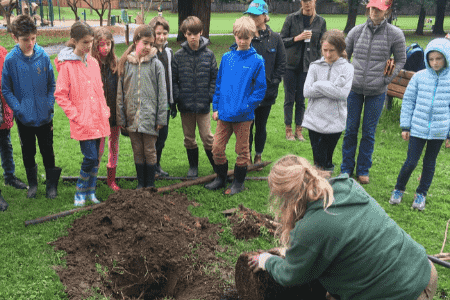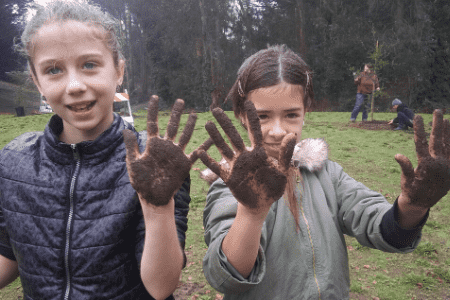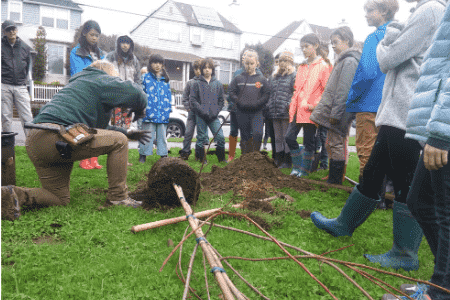
One Tree at a Time
Kids Who Plant Together Save the Planet Together
Green Family Living: February 2020
By John Louis Koenig
It was more than just a day in the park on a Wednesday for hard working kids from Santa Cruz Waldorf School, as 5th graders helped to plant 25 trees, oaks and maples, as part of Waldorf’s goal of planting 100 trees this school year.
“The kids had a blast,” said Leslie Keedy, said City of Santa Cruz Urban Forester and supervisor of the day’s tree planting at University Terrace Park near UCSC.

Keedy has been demonstrating to young and old how to plant trees as volunteers help to plant 500 trees funded by a Calfire Forestry & Clean air grant.
“The maturity level of our young volunteers always amazes me,” Keedy says. “They are both enthusiastic and intellectual sponges.” She has noticed an increase in concern for the environment among young people, a concern that shows in the seriousness with which they lend their help.
“Whether working with peers or adults, their sense of teamwork is evident and they rise to the occasion.”
Keedy says that young people, 5th grade and up, are always welcome to volunteer with an accompanying adult. Parents sign waivers for themselves and their children, and young people are always given safe jobs to do.
With Greta Thunberg, Sweden’s 16-year-old climate change activist, being named Person of the Year by Time Magazine, the year 2020 may see an even greater increase in youth participation. Keedy cites her as an “amazing” example of what an individual can accomplish, calling her an articulate and thoughtful trendsetter and role model.

Planting trees is one of the most immediate ways of reducing carbon in the atmosphere according to a study published in the journal Science. In addition to the Cal Fire forestry grant, there has been additional funding from the State related to air quality and climate action. The community of Santa Cruz always engages in tree planting and has internal funding to support this action regardless of State or Federal contributions.
In addition to tree planting, young volunteers have been helping with the many other activities that assist the natural environment in Santa Cruz. Riparian zones are the areas that transition between land and water, whether rivers, lakes or seas. Restoring riparian areas is another of the city’s ongoing nature projects, involving clean-up and transitioning nonnative vegetation to a more native-plant ecology.
Volunteer events occur almost monthly on the San Lorenzo River levee for stewardship of the river and volunteers are always welcome.
The website environteers.org is an ideal place for parents and kids to discover opportunities to help preserve and save the environment. The site’s creator Andy Carman says there are events taking place weekly from south to north county, from the Watsonville wetlands and Elkhorn Slough where native plant restoration is important to the Santa Cruz beaches, rivers and forests.
Even farther north, Carman cites the volunteer farming offered by the Amah Mutsun Tribal Band at their Pie Ranch garden near Pescadero where kids can learn about the Ohlone Native Americans’ connection with the Earth while practicing their botanical skills.

Environteers sends out a weekly newsletter that announces a wealth of events including family friendly, nature-healing volunteer projects, organized by groups like Sierra Club, Coastal Watershed Club, Santa Cruz Natural History Museum, and Save Our Shores.
Leslie Keedy stresses how tree planting is the simplest way for community members to make a difference in our environment, whether by planting and caring for a tree in your own yard or working with local government on larger forestry tree planting projects. And, she notes it can bring families and neighbors together, building a sense of community and combining like-minded visions.
Asked for advice that she would pass along to young climate activists, Keedy cites a philosophy that has been shared since the 1970s and the first Earth Days.
“This all may seem a bit cliché,” she says, “but the words of wisdom are for our taking—think globally & act locally


You May Also Like

Jazz Isn’t Dead; It’s Alive and Well in SLV
February 1, 2020
Editor’s Note February 2020
February 1, 2020

